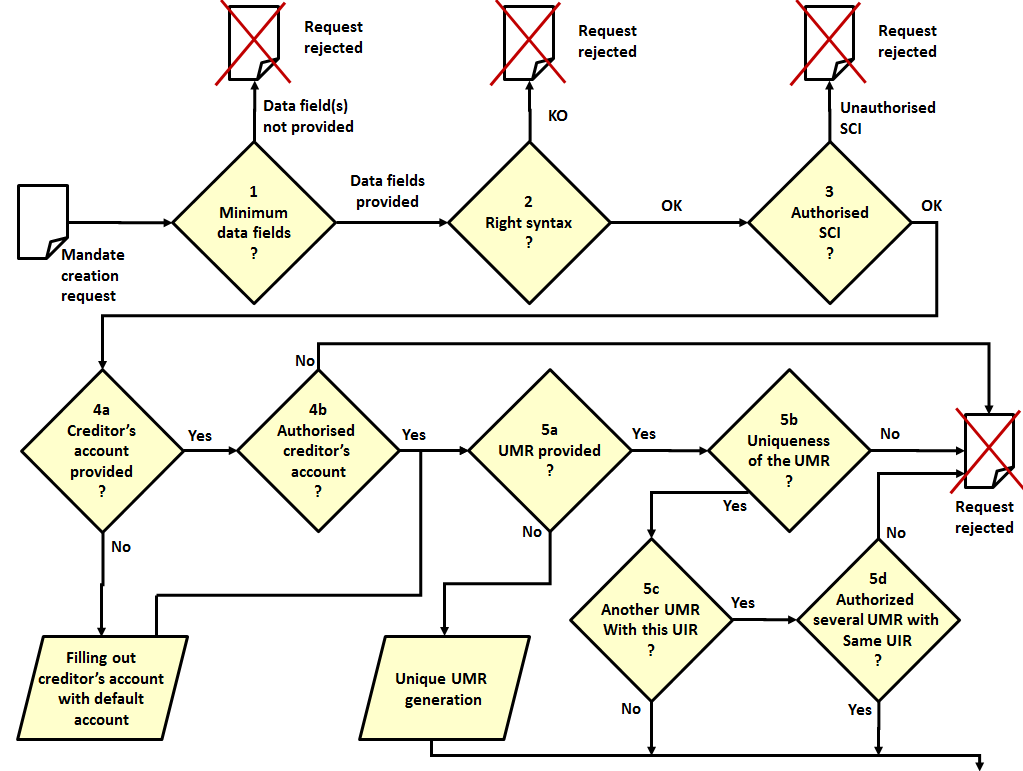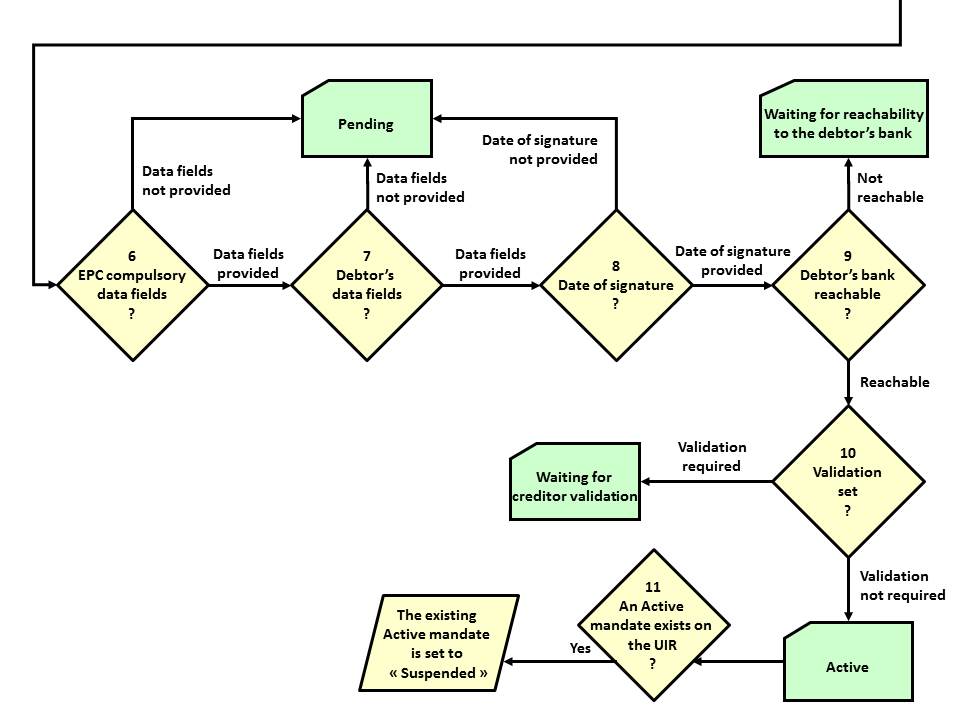General
Each creditor must digitize the data in each new paper mandate signed by a debtor client and archive this document within a period which complies with national regulations (a minimum of one year after the date when last direct debit falls due).
The data in the standard SEPA mandate are defined in the Presentation of mandate data. Whatever method is used to digitize the mandate, the only information relating to the creditor that is required for creation of the mandate is the SCI; the other information relating to the creditor is already available in the SEPA Payment Suite configuration.
Whenever a mandate is created, SEPA Payment Suite generates an audit trail which shows both the date/time when creation of the mandate was recorded and the origin of its creation (file name, request identifier or user login).
Furthermore, a parameter can be used to request validation by the creditor following creation of each mandate (See Double validation of a mandate).
The exchange methods supported for this operation are presented in Summary of modes of exchange by function.
Processing creation requests
When a creation request is received, SEPA Payment Suite carries out the following checks:
-
Minimum data fields have been completed in the creation request that has been entered;
-
Data field syntax in the creation request that has been entered;
-
SCI that has been entered is authorized for the creditor;
-
The creditor’s account that has been entered is authorized for the creditor. if it is not stated in the creation request, the creditor’s default account (as configured) is automatically selected;
-
Uniqueness of the UMR, (in the file and in the active mandates database for this creditor); if the UMR is not stated, SEPA Payment Suite may generate it according to a configured pattern;
-
Compulsory data fields (EPC standard) for issue of the mandate have been completed;
-
Debtor data have been entered and debtor’s bank data are consistent (i.e. BIC and IBAN);
-
Date of signature of the mandate (before or the same as the current date);
-
Reachability of the debtor’s bank;
-
Validation parameters after creation of the mandate if applicable.
-
If a mandate is already activated on this UIR, it will be set to the status “pending”.
If all these steps are successful, the mandate could be normally created in Active status, SPS will make sure that the UIR is not already used for this organization (if the parameter “Authorize the creation of mandates having the same UIR” is unchecked).
In the case the parameter “Authorize the creation of mandates having the same UIR” is activated by the organization and all the steps before were successfully executed and the current mandate could be created as an Active one, then:
- SPS will check if another active mandate with the same UIR already exists:
In that case the existing mandate will be suspended before the creation of this new one.
The creation of mandates having the same UIR is available only for Worldline files (xml and csv) and for the CFONB with a customized mapping (where the location of an UIR and of an UIR can be specified).


Picture 7: Workflow for creation of a mandate
If one of checks 1-5 fails, the mandate creation request is rejected: the request is not registered in the database and an UMR is not generated.
If the checks are successful, SEPA Payment Suite registers the new mandate in its database. The status of the mandate depends on the result of checks 6-11:
“pending” if some of the data required to issue the mandate are missing from the request, if some of the compulsory data relating to the debtor have not been provided in the request, or if the date of signature of the mandate is missing from the request;
“Waiting for reachability” if the counterparty bank is not accessible on the mandate scheme;
“Waiting for creditor validation” if the creation validation parameter has been set;
“Active” if the mandate contains all the necessary data (including date of signature), the debtor’s bank is accessible and the validation parameter has not been set. If an Active mandate is already exists on the UIR, the existing mandate is set to “Pending”.
Whatever the result of processing, SEPA Payment Suite generates a response to the request in accordance with its exchange method.
Creation of an Existing SEPA Mandate
SPS is able to create Mandates which already exist in the SEPA format in another system. When creating an existing mandate via GUI (Mandate type: Existing SEPA mandate), files (To be migrated: E for csv format, existingSepaMandate: true for xml format) or Web services (Mandate nature: IMPORTED_MANDATE), the due date of the last SDD sent must to be specified; thereby the first SDD treated by SPS will be considered as a recurrent and not as a first. If the due date of the last SDD sent is not given, it will be set at the current date.
Creation of Mandate with a wrong Debtor account
SPS allows creating mandates with a wrong Debtor account (BIC+IBAN) if the option “Authorize the creation of mandates having a wrong debtor account” is activated for the selected Organization. The mandate will be created with pending status. A warning message is displayed at the user to inform him that the mandate is pending and the erroneous Debtor account is displayed in RED.
Creation of Mandate with Fraud Control Check
SPS allows creating mandates with a fraud control check. If the SPS Fraud option and fraud profile is active on the organization then only creating mandate comes under the Fraud Control check. When creating the mandate if the Fraud Configuration for the web is activated and fraud decision is Red then it blocks the creation of the mandate and displays the error message. But if Fraud Configuration for the web is deactivated and fraud decision is red then it allows the creation of mandate and display a warning message only.